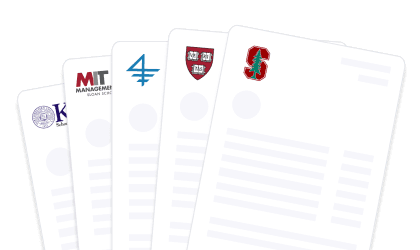What Admissions Really Looks For: AMA w/ a Former Admissions Officer

Join a free event
Learn from top coaches and industry experts in live, interactive sessions you can join for free.
Table of Contents
The Columbia MBA Employment Report is a significant resource for students and alumni of Columbia Business School. This comprehensive report provides valuable insights into the employment landscape for MBA graduates, shedding light on various key aspects such as industry trends, hiring statistics, salary projections, and career prospects. Understanding the report and leveraging its findings can greatly impact one's career planning and decision-making process. In this article, we will delve into the importance of the Columbia MBA Employment Report, analyze its key terms and figures, explore sector-wise employment statistics, examine the geographical distribution of employment, highlight the top hiring industries and companies, discuss salary trends and projections, uncover major takeaways from the report, explore career prospects for Columbia MBA graduates, and provide guidance on how to align career goals with industry trends and leverage the report for job search strategies.
Overview of the Columbia MBA Employment Report
The Columbia MBA Employment Report holds immense significance for current students and alumni, as it offers valuable insights into the current job market and hiring trends. By thoroughly analyzing the data provided in the report, one can gain a comprehensive understanding of the employment landscape for MBA graduates from Columbia Business School. This information helps individuals make informed decisions regarding their career paths and enables them to plan strategically for the future.
The Importance of the Employment Report
The Columbia MBA Employment Report acts as a compass, guiding students and alumni in navigating their career paths. It provides an overview of the industries and sectors that are actively hiring MBA talent, allowing individuals to identify potential job opportunities.
For instance, the report may reveal that the finance industry is currently experiencing a surge in demand for MBA graduates. Armed with this knowledge, students and alumni can tailor their job search strategies to target finance-related roles, such as investment banking or private equity.
Additionally, the report sheds light on the demand for MBA graduates in different geographical locations, unveiling potential relocation prospects. It may indicate that certain cities or regions are experiencing rapid growth and offer promising job prospects for MBA graduates.
By understanding these key aspects, students and alumni are better equipped to make informed decisions about their career trajectories. They can align their skills and interests with the industries and locations that offer the most promising opportunities, ultimately increasing their chances of securing fulfilling and lucrative positions.
Decoding the Report: Key Terms and Figures
Before diving into the detailed analysis of the report, it is crucial to familiarize oneself with the key terms and figures presented. The report covers various metrics, including employment rates, salary averages, signing bonuses, and more.
Employment rates provide insights into the overall success of MBA graduates in securing job offers. They indicate the percentage of graduates who have found employment within a certain timeframe after completing their MBA program. This figure can help individuals gauge the competitiveness of the job market and understand the demand for MBA talent.
Salary averages offer a glimpse into the earning potential of MBA graduates. They provide an overview of the typical compensation packages that graduates can expect in various industries and roles. This information can be crucial in negotiating job offers and setting realistic salary expectations.
Signing bonuses, on the other hand, represent one-time payments offered to MBA graduates upon accepting a job offer. These bonuses are often used by employers to attract top talent and incentivize candidates to join their organizations. Understanding the average signing bonus amounts can provide insights into the competitiveness of the job market and the value placed on MBA skills and qualifications.
By deciphering and interpreting these figures correctly, individuals can gain accurate insights into the job market. They can identify trends, understand industry dynamics, and make informed decisions about their career paths based on the data presented in the report.
Detailed Analysis of the Employment Report
Delving deeper into the Columbia MBA Employment Report, it is evident that the data is presented in a comprehensive and organized manner. Various sections of the report provide in-depth analysis of the different aspects of MBA employment, allowing for a more nuanced understanding of the current job market trends.
Sector-wise Employment Statistics
One of the crucial insights provided by the report is sector-wise employment statistics. It breaks down the types of industries and sectors that hire MBA graduates from Columbia Business School. By analyzing this information, individuals can identify the sectors that might be a good fit for their skills and interests. This section of the report helps students and alumni to assess the demand for MBA talent in various industries and make informed decisions about their career paths.
Geographical Distribution of Employment
The report also offers valuable insights into the geographical distribution of employment opportunities for Columbia MBA graduates. It highlights the locations where the demand for MBA talent is the highest, allowing individuals to consider potential job markets for relocation. This section helps students and alumni explore opportunities in different regions and align their career goals with the geographical preferences that suit their aspirations.
Key Insights from the Employment Report
Extracting valuable insights from the Columbia MBA Employment Report is beneficial for students and alumni alike. By identifying the key trends and patterns, individuals can gain a competitive edge in the job market and make more informed decisions regarding their career goals and strategies.
Top Hiring Industries and Companies
One of the major takeaways from the report is the identification of the top hiring industries and companies for Columbia MBA graduates. This information empowers individuals to target their job search efforts effectively and align their skills and interests with the industries and organizations that have a higher demand for MBA talent. By focusing on these top hiring industries and companies, students and alumni can improve their chances of securing desirable employment opportunities.
Salary Trends and Projections
The Columbia MBA Employment Report also provides valuable insights into salary trends and projections. It unveils the average salaries, signing bonuses, and other compensation components within different industries and sectors. This information allows individuals to gauge earning potential and make informed decisions regarding salary negotiations. By staying abreast of the salary trends and projections, students and alumni can ensure that their compensation expectations align with the current market standards.
Major Takeaways from the Report
After thoroughly analyzing the Columbia MBA Employment Report, several major takeaways emerge that can significantly impact career planning and decision-making.
Career Prospects for Columbia MBA Graduates
The report highlights the promising career prospects for Columbia MBA graduates, reinforcing the value of the degree in the job market. It reveals the variety of industries and sectors that actively seek MBA talent, providing individuals with a wide range of career options. By understanding the career prospects, students and alumni can make informed choices about the direction they want to take their careers.
Future Trends and Predictions
Another key takeaway from the report is the identification of future trends and predictions in the job market. By analyzing the data and insights presented, individuals can anticipate the evolving needs of employers and the changing dynamics of the job market. By staying ahead of these trends and predictions, students and alumni can proactively adapt their skills and knowledge to remain competitive in the fast-paced business world.
How to Use this Information for Career Planning
The Columbia MBA Employment Report is a valuable resource that can greatly assist in career planning and strategy development. By leveraging the report's findings, individuals can position themselves for success in the job market and align their career goals with industry trends.
Aligning Career Goals with Industry Trends
One way to utilize the report is by aligning career goals with industry trends. By understanding the demand for MBA graduates in different industries, individuals can identify the sectors that are expected to experience rapid growth. This knowledge allows individuals to tailor their skill sets and experiences to match the needs of these industries, increasing their marketability and career prospects.
Leveraging the Report for Job Search Strategies
Additionally, the report can be used to develop effective job search strategies. By identifying the top hiring industries and companies, individuals can focus their job search efforts on these target areas. This approach increases the likelihood of securing desirable employment opportunities and streamlines the job search process. Moreover, by staying informed about salary trends and projections, individuals can negotiate salary packages more effectively and make informed decisions about job offers.
In conclusion, the Columbia MBA Employment Report provides invaluable insights and takeaways for students and alumni of Columbia Business School. By understanding and utilizing the information presented in the report, individuals can make informed decisions about their career paths, align their goals with industry trends, and increase their chances of securing desirable employment opportunities. It is crucial for students and alumni to leverage the report's data, analyze the key terms and figures, explore sector-wise employment statistics, and consider the geographical distribution of employment opportunities. By capitalizing on the major takeaways and using the report strategically, individuals can pave the way for a successful and fulfilling career in their desired industries and sectors.
Browse hundreds of expert coaches
Leland coaches have helped thousands of people achieve their goals. A dedicated mentor can make all the difference.



























